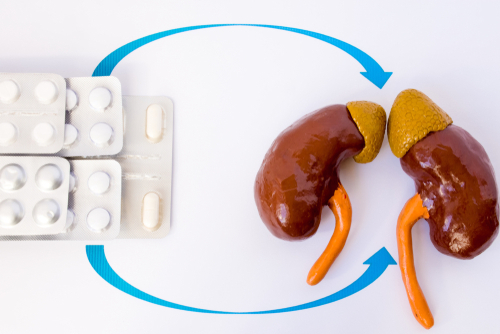Resolvin D-1 limits kidney damage after heart attacks
University of Alabama School of Medicine Feb 23, 2018

A heart attack triggers an acute inflammatory response at the damaged portion of the heart’s left ventricle. If this acute inflammation lingers, it can lead to stretching of the ventricle and heart failure. The inflammation can claim another victim—the kidneys.
New research shows that a bioactive compound called resolvin D-1, injected as a therapeutic dose, is able to limit this collateral damage in the kidneys, as tested in an animal model. This suggests potential application to the clinical setting.
In experiments led by Ganesh Halade, PhD, assistant professor in the Division of Cardiovascular Disease, University of Alabama at Birmingham Department of Medicine, resolvin D-1 was given 3 hours after a heart attack. Resolvin D-1 is a bioactive mediator produced by immune cells for cell-to-cell signaling, and it is part of the natural innate immune response that resolves inflammation.
Inflammation after tissue injury has two steps—an acute response, where white blood cells rush to the heart to remove dead tissue, and a resolving phase, where inflammation is dampened, reparative macrophages arrive, and scar tissue forms. Both responses are under active control, governed by ‘get in’ and ‘get out’ signals to infiltrating leukocytes, but active control of the resolving response is less well understood.
In a paper published in The FASEB Journal, Halade and colleagues found that resolvin D-1 limits heart attack-induced kidney inflammation in their mouse model, and they showed three innovative mechanistic actions for resolvin D-1.
First, resolvin D-1 improved leukocyte clearance from heart attack tissue after the initial acute response. This clearance is paramount because the magnitude of neutrophils' swarming in after a heart attack correlates with early progressive development of congestive heart failure. Resolvin D-1 facilitated this clearance without affecting the acute recruitment response. Resolvin also hastened the change of macrophages in the heart tissue from classic macrophages to reparative macrophages, which indicated an expedited healing response.
Second, resolvin D-1 was able to calm the microRNA storm that develops in heart attack tissue, and it accelerated production of regenerative microRNAs in the resolving phase after the heart attack. In heart attack mice not given resolvin D-1, 12 microRNAs were significantly up-regulated and seven were significantly down-regulated. With resolvin D-1, only one was up-regulated and three were down-regulated. MicroRNAs control diverse gene expression in cardiac injury.
Third, resolvin D-1-mediated clearance of leukocytes reduced the amount of collateral kidney injury, as measured by histopathology and kidney injury markers. Resolvin D-1 attenuated the signs of kidney inflammation that were seen in heart attack mice not given the bioactive mediator—the non-resolvin D-1 animals had distorted kidney morphology, enhanced levels of the kidney injury marker NGAL, and diminished amounts of nephrin—a protein necessary for proper functioning of the kidney—in the podocytes of the kidney filtering structure.
Furthermore, resolvin D-1 reduced levels in kidney tissue of the proinflammatory cytokine mRNAs for Il-6, Il-1-beta, Tnf-alpha, and Tgf-beta, and it increased the levels for the reparative cytokines Mrc-1 and Ym-1.
-
Exclusive Write-ups & Webinars by KOLs
-
Daily Quiz by specialty
-
Paid Market Research Surveys
-
Case discussions, News & Journals' summaries